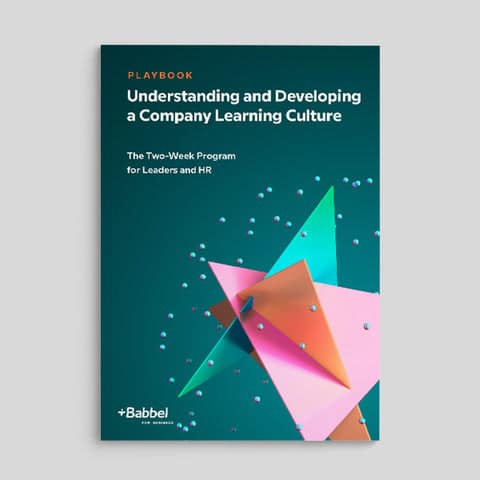In this article, we explore one of the leading learning and development trends: microlearning. Discover what microlearning is as well as why it’s beneficial, and learn some best practices for delivering it successfully.
Employee learning and development (L&D) is a strategic priority for 2023. Not only does it help employers to close critical skills gaps — it also plays a role in keeping employees engaged. But in the era of busy schedules and information overload, building effective yet realistic training initiatives can be challenging.
Increasingly, employers are swapping lengthy (and often unengaging) training programs for an approach known as microlearning. But what does that actually mean and what does it look like in action? Is it really an effective way to train and upskill employees?
If you’re new to microlearning — or want to gain a better understanding of how to use it — then this guide is for you. We cover everything you need to know, including:
- What is microlearning? A definition
- The origins of microlearning
- Some real-world examples of microlearning
- What are the benefits of microlearning?
- Microlearning best practices
So: What exactly is microlearning? Let’s take a look in the next section.
 Develop a sustainable learning culture for your team
Develop a sustainable learning culture for your team
In our free playbook “Understanding and Developing a Company Learning Culture” you will receive helpful guidance and tips.
What is microlearning? A definition
Microlearning literally means ‘very small learning.’ It takes a concise, bite-sized approach to education and training, breaking a topic down into small snippets of content which can be consumed in a matter of minutes.
Each segment of microlearning content is highly focused and to the point, presenting only the most relevant information and covering just one or two specific learning objectives. It’s designed to be manageable, engaging, and easier to retain than long-form learning content.
To better understand what microlearning is and why it’s useful, let’s explore where it comes from.
The origins of microlearning
In 1865, German psychologist Hermann Ebbinghaus set out to understand why we forget things and how we can improve our ability to retain information. He ran a series of experiments, testing his own memory after different lengths of time.
Based on his findings, Ebbinghaus produced what’s known as the ‘forgetting curve’ — a graph which depicts how our retention of information tends to fade over time.
Not only did Ebbinghaus find that our memories weaken over time if we don’t revisit or relearn the information acquired — he also found that the biggest drop in retention happens right after learning. At the same time, our ability to recall certain information is impacted by how well it’s communicated and presented in the first place.
Microlearning evolved as a way to combat the forgetting curve by reducing the cognitive load on the learner — in other words, not asking the brain to do too much at once. The first known use of the term ‘microlearning’ can be traced back to a book called The Economics of Human Resources by Hector Correa in 1963. However, it really took off in the early 2000s with the rise of the smartphone industry.
With on-demand access to the Internet and a wealth of mobile apps, consuming bite-sized content on the go became the norm. And now, in the era of short attention spans and busy schedules, microlearning is an extremely powerful — and popular — tool.
Find out in another blog post, how managers can contribute to their team’s learning motivation.
What are some examples of microlearning?
Microlearning takes many different forms. While it’s usually technology-based, you’ll also find examples of microlearning content in the physical world, too.
Some common microlearning examples include:
- Infographics: Consider the in-flight safety cards found on airplanes which use a series of images to teach you about certain safety procedures, or digital infographics which sum up key facts and figures.
- Mobile apps: For example, language-learning apps which use short exercises, quizzes, and games to encourage daily learning on the go.
- Email digests: This is microlearning delivered straight to your inbox, like the word-of-the-day emails sent by Merriam-Webster which teach you the meaning and etymology of a new word each day.
- Microlearning videos: Short explainer videos or tutorials which present a key snippet of information using both visuals and audio.
- Podcasts: For example, the Grammar Girl ‘Quick and Dirty Tips for Better Writing’ podcast which teaches useful writing hacks via short, 10-minute episodes.
- Interactive games and challenges: These include flashcards, polls, and quizzes which require active participation from the learner and may involve some kind of reward, such as points or badges.
Regardless of format, all microlearning content should be succinct, engaging, and deliver just one or two key takeaways.

What are the benefits of microlearning?
There are many benefits of microlearning. It’s quick and focused, it lends itself to flexibility and personalization, and it can be easier (and cheaper) to deliver. Let’s consider some of the many reasons you might choose to incorporate microlearning into your workplace L&D strategy.
1. Microlearning is quick and efficient
Microlearning is ideal for busy schedules and short attention spans. It mimics the way we tend to consume content in our daily lives — in short snippets via social media feeds and push notifications. It also overcomes one of the biggest barriers to workplace learning: time. Microlearning is quick and efficient, making it easier to fit into the working week.
2. Microlearning is more manageable (and therefore less overwhelming)
Because it’s so quick and concise, microlearning is instantly perceived as a more manageable, less overwhelming way to learn. 65% of employees say they are overwhelmed by the amount of information presented in traditional training courses — and 58% would spend more time learning at work if the content were presented in shorter chunks.
3. It puts the learner in control
Microlearning offers a flexible, on-demand way to learn. It can be done on the job, at the learner’s convenience and right at the moment they need certain information or to pick up a particular skill. As such, it provides a more personalized, continuous learning experience than a one-size-fits-all, one-time training course. The learner is in control of what they learn and when, effectively devising their own learning path based on their needs.
4. Microlearning improves knowledge retention
Microlearning boosts knowledge retention by at least 50% because it plays into how our brains work. Learning in smaller increments spaced out over time helps to move the information from short-term to long-term memory, while shorter learning sessions reduce mental fatigue. It’s easier to stay focused and engaged for five minutes than, say, an hour.
5. It’s cost-effective
According to learning expert Ray Jimenez, microlearning reduces e-learning content development time by 300%. Not only is it quicker to produce — it typically results in higher completion rates, more efficient learning, and it’s easily scalable. Overall, microlearning can be more cost-effective than traditional training programs.
In episode 16 of our podcast, we discover how to keep up motivation while learning a new language. Listen here:
Microlearning best practices: 4 Tips to help you get started
If you’re keen to leverage microlearning at your company, there are certain best practices you’ll need to follow. Let’s explore those now.
1. Recognize that microlearning has its limitations
For all its benefits, microlearning isn’t necessarily the best option for every type of training. When it comes to more complex or high-stakes topics, short, bite-sized content might not be suitable. Before you start creating or investing in microlearning content, first consider whether it’s the most appropriate means for your training objectives and the wider context.
2. Always start with a clear goal in mind
As with any kind of learning and development initiative, it’s important to start with a clear goal in mind. Define exactly what your microlearning program should achieve — in other words, what new knowledge should your learners acquire from it, or what skill should they have mastered by the end? You can then break your overarching objective into smaller, more manageable units that will form the basis of your microlearning content.
3. Use gamification to encourage continuous learning
80% of US workers believe that game-based learning is more engaging. If you want to encourage continuous and regular learning, use gamification techniques such as quizzes, rewards, streaks, and score boards to keep your learners actively engaged and coming back for more.
4. Hold your learners accountable
A potential drawback of microlearning is that your employees may not perceive it to be as formal or as important as traditional forms of training. You can combat this by holding your learners accountable. Set goals, use micro-assessments to track individual progress, and make sure your employees understand why a particular learning pathway is necessary and valuable.
With these best practices in mind, you can create effective, goal-driven microlearning programs that your employees will actually enjoy.
 Develop a sustainable learning culture for your team
Develop a sustainable learning culture for your team
In our free playbook “Understanding and Developing a Company Learning Culture” you will receive helpful guidance and tips.





